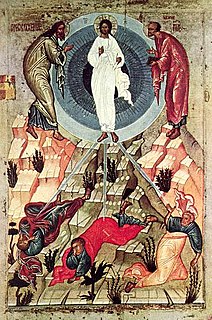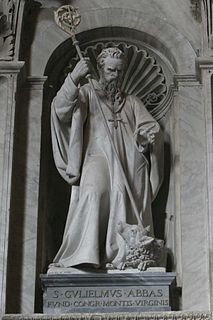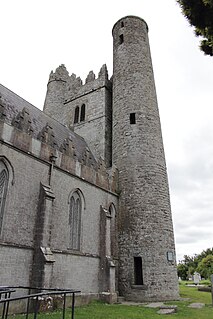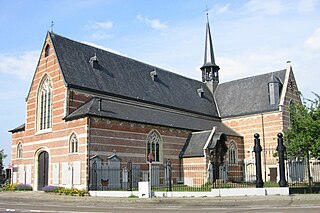Related Research Articles

Brendan of Clonfert Brénainn moccu Alti or Brénainn maccu Alti, also referred to as "Brendán moccu Altae", called "the Navigator", "the Voyager", "the Anchorite", and "the Bold", is one of the early Irish monastic saints and one of the Twelve Apostles of Ireland. He is primarily renowned for his legendary quest to the "Isle of the Blessed", also denominated "Saint Brendan's Island". The Navigatio Sancti Brendani Abbatis can be described as an immram, i. e., Irish navigational narrative.

Christian monasticism is the devotional practice of Christians who live ascetic and typically cloistered lives that are dedicated to Christian worship. It began to develop early in the history of the Christian Church, modeled upon scriptural examples and ideals, including those in the Old Testament, but not mandated as an institution in the scriptures. It has come to be regulated by religious rules and, in modern times, the Canon law of the respective Christian denominations that have forms of monastic living. Those living the monastic life are known by the generic terms monks (men) and nuns (women). The word monk originated from the Greek μοναχός, itself from μόνος meaning 'alone'.
Breage or Breaca is a saint venerated in Cornwall and South West England. According to her late hagiography, she was an Irish nun of the 5th or 6th century who founded a church in Cornwall. The village and civil parish of Breage in Cornwall are named after her, and the local Breage Parish Church is dedicated to her. She is a saint in the Eastern Orthodox Church and Catholic Church.

June 17 - Eastern Orthodox Church calendar - June 19

William of Montevergine, or William of Vercelli,, also known as William the Abbot, was a Catholic hermit and the founder of the Congregation of Monte Vergine, or "Williamites". He is venerated as a saint by the Roman Catholic Church.

Aredius, also known as Yrieix and Saint Aredius, was Abbot of Limoges and chancellor to Theudebert I, King of Austrasia in the 6th century. He founded the monastery of Attanum, and the various French communes called St. Yrieix are named after him.

Saint Hervé, also known as Harvey, Herveus, or Houarniaule, was a sixth-century Breton saint. Along with Saint Ives, he is one of the most popular of the Breton saints. He was born in Guimiliau (Gwimilio).

According to Catholic tradition, Saint Amaro or Amarus the Pilgrim was an abbot and sailor who it was claimed sailed across the Atlantic Ocean to an earthly paradise. There are two historical figures who may have provided the basis for this legend. The first was a French penitent of the same name who went on a pilgrimage to Santiago de Compostela in the thirteenth century. On his return journey, he established himself at Burgos, where he founded a hospital for lepers.

Deodatusof Nevers was a bishop of Nevers from 655. Deodatus lived with Arbogast in the monastery of Ebersheim, established by Childeric II near Sélestat in the forest of Haguenau.
Saint Rusticus, the successor of Saint Lupicinus of Lyon (491-494), served as Archbishop of Lyon from 494 to April 501. Later canonized, his feast day is 25 April.

Eymoutiers is a commune in the Haute-Vienne department in the Nouvelle-Aquitaine region in western France.

Maurontius of Douai was a nobleman and Benedictine abbot. His parents were Rictrude and Adalbard. He is a Catholic saint, with a feast day on May 5, especially venerated in Douai, France. His sisters Clotsinda, Adalsinda and Eusebia of Douai are also saints.
Barontius (Barontus) and Desiderius were two 8th century hermits who are venerated as saints by the Catholic Church. They were hermits near Pistoia, in Italy.
Saint Senan of Laraghbrine, County Kildare, was an Irish Christian monk who lived towards the end of the 6th century. His father was Fintan, son of Strened, son of Glinder, son of Corc, son of Conned, son of Aengus, son of Fieg, son of Mail, son of Carthage of the race of Eochaidh.

Finan Cam, Abbot of Kinnity was an early Irish saint associated with County Kerry, Ireland, who lived in the 6th century AD, and possibly the 7th century. To distinguish him from other saints of the same name the appellation of Cam or "crooked" has been given to him, either because he was stooped or because he had a squint. His feast day is 7 April.

Saint Macculind was an early Irish saint who was abbot or bishop of Lusk.
Saint Bécán was an Irish monk who founded a monastery at Kilbeggan and is considered by some to be one of the Twelve Apostles of Ireland. His feast day is 5 April.

Saint Fredigand of Deurne was an 8th-century Irish missionary in the territory around Antwerp in what is now Belgium. His feast day is 17 July.
Saint Dotto was said to have founded a monastery on one of the Orkney Islands, which bore his name. However, there is no island by that name, and no evidence that he existed. His feast day is 9 April.
Saint Wasnulf was a Scottish missionary in what is now Belgium. His feast day is 1 October.
References
- 1 2 3 4 "Den hellige Psalmodius av Limoges". Katolsk. 2009. Retrieved 6 May 2009.
- 1 2 3 "Den hellige Psalmodius av Limoges". Heiligen-3s. n.d. Retrieved 6 May 2009.
- 1 2 3 4 5 6 "Saint Psalmet". Mairie de Eymoutiers. n.d. Retrieved 6 May 2009.
- 1 2 3 4 Alban Butler, The Lives of the Fathers, Martyrs, and Other Principal Saints (B. Dornin, 1821), 213.
- 1 2 3 4 5 John O’Hanlon, Lives of the Irish Saints (Original from Oxford University, 1873. Digitized Aug 30, 2006), 658.
- 1 2 3 4 5 6 7 8 John O’Hanlon, Lives of the Irish Saints (Original from Oxford University, 1873. Digitized Aug 30, 2006), 659.